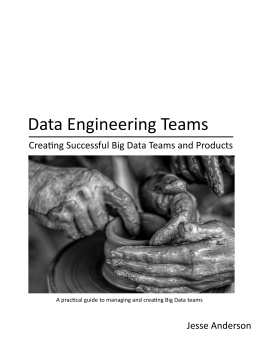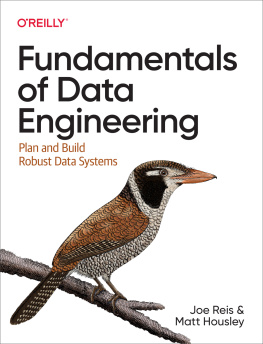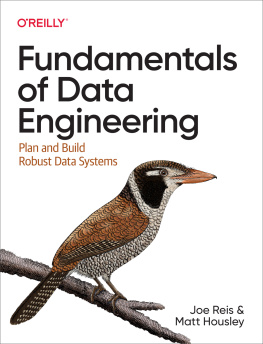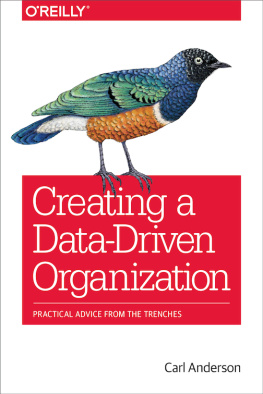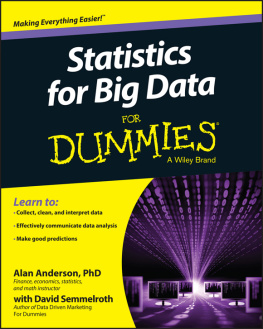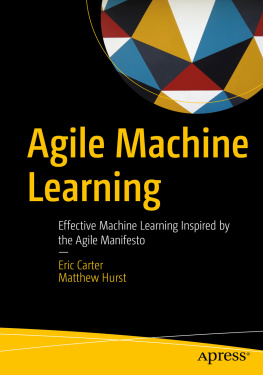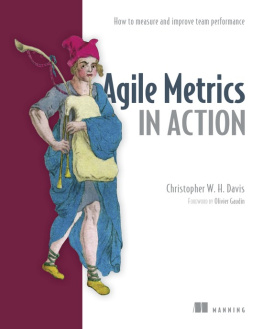Jesse Anderson - Data Engineering Teams
Here you can read online Jesse Anderson - Data Engineering Teams full text of the book (entire story) in english for free. Download pdf and epub, get meaning, cover and reviews about this ebook. year: 2017, genre: Computer / Science. Description of the work, (preface) as well as reviews are available. Best literature library LitArk.com created for fans of good reading and offers a wide selection of genres:
Romance novel
Science fiction
Adventure
Detective
Science
History
Home and family
Prose
Art
Politics
Computer
Non-fiction
Religion
Business
Children
Humor
Choose a favorite category and find really read worthwhile books. Enjoy immersion in the world of imagination, feel the emotions of the characters or learn something new for yourself, make an fascinating discovery.
- Book:Data Engineering Teams
- Author:
- Genre:
- Year:2017
- Rating:3 / 5
- Favourites:Add to favourites
- Your mark:
- 60
- 1
- 2
- 3
- 4
- 5
Data Engineering Teams: summary, description and annotation
We offer to read an annotation, description, summary or preface (depends on what the author of the book "Data Engineering Teams" wrote himself). If you haven't found the necessary information about the book — write in the comments, we will try to find it.
Data Engineering Teams — read online for free the complete book (whole text) full work
Below is the text of the book, divided by pages. System saving the place of the last page read, allows you to conveniently read the book "Data Engineering Teams" online for free, without having to search again every time where you left off. Put a bookmark, and you can go to the page where you finished reading at any time.
Font size:
Interval:
Bookmark:

Creating Successful Big Data Teams and Products
Jesse Anderson
Youre starting to hear, or have been hearing for a while, your engineers say cant. The cants always revolve around processing vast quantities of data. Sometimes, youre asking for an analysis that spans years. Youre asking for processing that spans billions of rows or looks at every customer you have. Other times, youre just asking for the day-to-day reports and data products that are the lifeblood of your business. Every time, there is a technical limitation thats keeping you from accomplishing your goal. You find yourself having to compromise every single time due to the technology.
Youre sitting on a big pile of data. A BIG pile. Buried somewhere in there are a bunch of really, really valuable insights. The kind of insights that could fundamentally and deeply change your business. Maybe you could more deeply understand your customers and reveal every time theyve purchased from you. Maybe it has to do with fraud or customer retention.
You, or your boss, have heard about Big Data, this magic bullet that everyone is talking about. Its allowing companies to free themselves of their technical limitations. Its also allowing your competition to move past you.
Heres the good news: I can help. In fact, Ive been helping companies do this for the past 6+ years.
Heres the not-so-good news: the process isnt magic and Big Data only seems like a magic bullet to the outside observer. In fact, a lot of hard work goes into making a successful Big Data project. It takes a team with a lot of discipline, both technical and managerial.
Now back to the good news. Ive seen, helped, and mentored a lot of companies as theyve gone through this process. I know the things that work, and more importantly, I know the things that dont. Im going to tell you the exact skills that every team needs. If you follow the strategies and plans I outline in this book, youll be way ahead of the 85% of your competitors who started down the Big Data road and failed.
When your competitors or other companies talk about Big Data technologies failing or their project failing due to the technologies, theyre not recognizing a key and fundamental part of the project. They didnt follow the strategies and plans I outline in this book. They lay the blame squarely on the technology. The reality lies several months or a year earlier, when they started the project off on the wrong foot. Ill show you how to start it off right and increase your probability of success.
This book is the result of years of carefully observing teams and entire companies. Ive also spent years teaching at hundreds of companies and to thousands of students. These companies span the world and are in all kinds of industries. My work starts with my very first interaction with teams and continues as I follow up with those teams to see how their project went. From there, I analyze what went right, what went wrong, and why.
Throughout this book, Im going to share some of these interactions and stories. Theyll look something like this:
Caution: A cautionary story Learn from this companys mistake(s)
These will be cautionary tales from the past. Learn from and avoid those mistakes.
Do This: Follow this example Learn from this companys success
These will be success stories from the past. Learn from and imitate their success.
My Story: My story Heres a story that will give you more color on the subject.
These will be stories or comments from my experience in the field. They will give you more background or color on a topic.
This book is primarily written for managers, VPs, and CxOspeople who are managing teams that are about to, or are currently, creating a Big Data solution. It will help them understand why some teams succeed but most teams fail.
Enterprise and Data Architects are tasked with being the bridge between the technical and business sides of the company. They have to make sure that the technology meets the needs of the business. Theyre the tip of the spear in advocating the need for Big Data technologies. This book will help them understand how to set the technical team up for success and the pitfalls to avoid.
Team leads, technical leads, and individual contributors have appreciated this book, too. Theyre often on the receiving end of why Big Data teams fail. This book will help these individuals understand the problems behind these failures so they can work with their management team to fix the issues.
I highly suggest you read the entire book from start to finish to understand every concept and point. Without the entire background and all of the concepts, you may not understand fully why I recommend a technique or make a specific suggestion.
Here are the chapters and what well be covering in each chapter:
- Chapter 1 will show you the reasons a data engineering team needs to exist. The key lies in the complexity of Big Data. A manager or team that doesnt internalize this fact is doomed to failure.
- Chapter 2 shows you what a data engineering team is and what makes it up. Ill talk about what makes a team successful and the common patterns of the unsuccessful teams.
- Chapter 3 will talk about the Data Engineers themselves. Ill show you how and why Data Engineers are different from Software Engineers.
- Chapter 4 shows you how to make your data engineering team productive after youve created it. Ill illustrate how data engineering teams function within an organization and how they interface with the rest of the company.
- Chapter 5 covers how to create data pipelinesthats what data engineering teams create. Ill share the ways I teach data engineers to create the most performant, reliable, and time-efficient pipelines.
- Chapter 6 shares the secrets to creating Big Data successful projects. Ill talk about how to break up the project into the manageable pieces, and share the reasons why teams succeed and fail.
- Chapter 7 shows you the exact steps to creating Big Data solutions. Ive taught these steps to companies all over the world. Theyve used them to increase their probability of success. Dont just skip to this chapter and think youre going to be successful.
A DBA (Database Administrator) is someone who maintains a database and often writes SQL queries. For the purposes of this book, Im going to group several different titles that write SQL queries together for simplicitys sake. In addition to DBA, these titles would be Data Warehouse Engineer, SQL Developer, and ETL Developer.
I will use the terms Software Engineer and programmer interchangeably. Both are someone who has programming or software engineering skills. They are the team member responsible for writing the projects code.
With all that negative stuff and housekeeping out of the way, lets start mining for gold. # The Need for Data Engineering
Here is one buzzword subheading to get your attention. At its core, this is why we need data engineering teams. We have a proliferation of data and theres a massive of amount of potential business value in it. We have a high demand for data products that unlock business value, but a low supply of people who can create them.
Font size:
Interval:
Bookmark:
Similar books «Data Engineering Teams»
Look at similar books to Data Engineering Teams. We have selected literature similar in name and meaning in the hope of providing readers with more options to find new, interesting, not yet read works.
Discussion, reviews of the book Data Engineering Teams and just readers' own opinions. Leave your comments, write what you think about the work, its meaning or the main characters. Specify what exactly you liked and what you didn't like, and why you think so.

